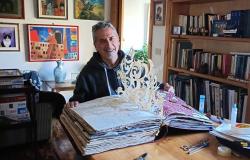Unplugged, disconnected. It is the adjective that Formafantasma choose to give us a still image of their domestic dimension: a totally disconnected place in which to gather. We are on the third floor of a 1930s building in the Central Station area: “Silence reigns here, not even a note plays”, they point out Simone Farresin and Andrea Trimarchi, opening the doors of their first Milanese apartment exclusively to Living. As much as the space inside is punctual, private and welcoming, the landscape outside strains the gaze: «The area is not particularly sexy, but when you pass the entrance to our house, what opens up to you is truly special», says Andrea. «The large courtyard, overlooked by six buildings, seems to smile at you», recalls certain suspended atmospheres of the neighborhoods of Sant’Elena in Venice, but also of Garbatella in Rome.
«I like this idea of a garden city, of a slightly partisan place, which hides protected by the quiet». And then in a few minutes by bike, passing through Martesana, they manage to reach Via Assab, where they have their studio. «Slow movement, never mechanical, is a habit cultivated in Holland», where they lived close to the water channels, «a necessity that returns, as well as a certain familiarity with Calvinism», a cultural imprint that the designers trace even in frenetic Milan. «This space is very 70s, but it is also very ours», says Andrea while caressing Terra, the little greyhound. Simone, leaning against the steel counter, unwraps a pod and prepares the coffee: next to the cup he places a desaturated dark brown chocolate, like the velvet of the sofa in the living area. “We designed it,” he says, referring to the sofa. The chocolate-caramel-date triptych instead comes from Bahrain, where he has just returned. Between space-time scale changes, chromatic shifts and sweetness, one wonders: but how do the Formafantasma live? As we see them photographed: in a environment punctuated with honest beauty.
More than designed, their creativity conveys the intensity of an interior tailored to your mood. Theirs. In these 100 square meters, which float in the light of a metropolis slightly yellowed by the rain, everything is perfect, harmonious, gentle. Surrounded by ocher tones, iconic armchairs, cute accessories (souvenirs of the heart) and custom-made furniture in cherry wood, designed to mark the functions of an open and passing space, the doubt arises: do you cook? «Of course», Simone replies. How can you not believe him. On the kitchen surface, among the Portuguese ceramics by Bordallo Pinheiro, Smith, Enzo Mari’s grater is irrefutable proof. «And we invite friends», very few, the most intimate ones. As soon as they cross the threshold of the house, a small landing covered in volcanic dust tiles from the ExCinere collection suggests them to place their shoes in the special side board on the wall and to shed their fear and become part of the family.


«For humans, living means building a safe place where you can feel good with the people you love», reflects Andrea. «The choice to surround ourselves with very few objects and books, only those we are reading, and to give up the TV, responds to our need to carve out a comfortable space for ourselves». He can only answer a broader and more radical idea of living. The same, moreover, at the center of their commitments at the Milan Design Week. From the delve into modernism to investigate the implications of gender, to consumption and the environmental crisis: the themes covered in The House Inside, their solo exhibition at the ICA Foundation and Being Home, the public program for Prada Frames, give us their idea of domestic size. «The house is the center of contemporary infrastructure and talking about it means addressing many current issues, including political and philosophical ones. The food we buy and the clothes we wear are the common thread between us and the impact that the volumes produced by large-scale retail trade and fast fashion have on the planet”, the connections are evident. «The home is the place in which the environment is reflected», conclude the designers, «that’s why here, everything that isn’t needed has no space». In life as in design.
Living © ALL RIGHTS RESERVED






